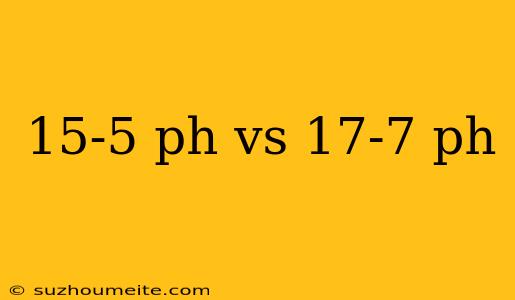15-5 PH vs 17-7 PH: Understanding the Differences
When it comes to stainless steel alloys, there are several types to choose from, each with its unique properties and applications. Two popular options are 15-5 PH and 17-7 PH, both of which are precipitation-hardening (PH) stainless steels. While they share some similarities, they also have distinct differences. In this article, we'll delve into the characteristics of each alloy and explore their differences.
What is 15-5 PH Stainless Steel?
15-5 PH is a precipitation-hardening stainless steel alloy that contains a combination of 14.5-15.5% chromium, 3.5-5.5% nickel, and 2.5-5.5% copper. It is known for its excellent mechanical properties, corrosion resistance, and weldability. 15-5 PH is often used in applications that require high strength, moderate corrosion resistance, and good ductility.
What is 17-7 PH Stainless Steel?
17-7 PH is another precipitation-hardening stainless steel alloy that contains a combination of 16-18% chromium, 6-8% nickel, and 0.5-1.5% aluminum. It is known for its exceptional mechanical properties, high temperature resistance, and excellent corrosion resistance. 17-7 PH is often used in applications that require high strength, high corrosion resistance, and good weldability.
Key Differences between 15-5 PH and 17-7 PH
Chemical Composition
The main difference between 15-5 PH and 17-7 PH lies in their chemical composition. 17-7 PH has a higher chromium content than 15-5 PH, which makes it more resistant to corrosion. Additionally, 17-7 PH contains aluminum, which is not present in 15-5 PH.
Mechanical Properties
Both alloys have high mechanical properties, but 17-7 PH has a higher tensile strength and yield strength than 15-5 PH. This makes 17-7 PH a better option for applications that require high strength and resistance to deformation.
Corrosion Resistance
17-7 PH has better corrosion resistance than 15-5 PH due to its higher chromium content. 17-7 PH is also more resistant to pitting and crevice corrosion than 15-5 PH.
Weldability
Both alloys are weldable, but 15-5 PH is more easily weldable than 17-7 PH. 15-5 PH can be welded using a variety of welding processes, including GTAW, GMAW, and SMAW. 17-7 PH, on the other hand, requires more specialized welding techniques and equipment.
Applications
15-5 PH is often used in applications such as aerospace, chemical processing, and marine hardware. 17-7 PH is often used in applications such as aerospace, power generation, and desalination plants.
Conclusion
In conclusion, while both 15-5 PH and 17-7 PH are precipitation-hardening stainless steel alloys, they have distinct differences in terms of chemical composition, mechanical properties, corrosion resistance, weldability, and applications. By understanding these differences, engineers and designers can make informed decisions about which alloy to use for their specific application.
